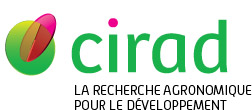Nyouma Achille, Bell Joseph Martin, Jacob Florence, Cros David. 2019. From mass selection to genomic selection: one century of breeding for quantitative yield components of oil palm (Elaeis guineensis Jacq.). Tree Genetics and Genomes, 15 (5):69, 16 p.
|
Version publiée
- Anglais
Accès réservé aux personnels Cirad Utilisation soumise à autorisation de l'auteur ou du Cirad. Nyouma2019_Article_FromMassSelectionToGenomicSele.pdf Télécharger (1MB) | Demander une copie |
Quartile : Q1, Sujet : HORTICULTURE / Quartile : Q2, Sujet : FORESTRY / Quartile : Q3, Sujet : GENETICS & HEREDITY
Résumé : More efficient methods are required to breed oil palm (Elaeis guineensis Jacq.) for yield maximization in order to meet the increased demand for palm oil while limiting environmental impacts. This review article analyzes the evolution of breeding schemes for oil palm yield and its quantative components and the changes expected to take place with genomic selection (GS). Genetic improvement of oil palm yield started in the 1920s through mass selection. Later, several disruptive improvements dramatically increased the rate of genetic progress: (1) understanding the heredity of fruit form and the adoption of tenera, with thicker mesocarp, in plantations; (2) the discovery of hybrid vigor and the adoption of modified reciprocal recurrent selection; and (3) clonal selection, exploiting intra-hybrid variability. In addition, the use of linear mixed models to estimate genetic values has made selection more efficient. Today, GS appears to be a new disruptive improvement that can speed up breeding schemes by avoiding field trials in some cycles and increase selection intensity by evaluating more candidates. The genetic potential for oil palm yield has increased considerably over one century of breeding. GS is expected to bring the rate of genetic progress to a previously unprecedented level. The future studies on oil palm GS will aim at making it efficient for all yield components. For this purpose, they should focus in particular on the optimization of training populations and on the improvement of prediction models. Minimizing environmental impacts will also require improvement in other aspects (resistance to diseases, cultural practices, etc.).
Mots-clés Agrovoc : Elaeis guineensis, amélioration des plantes, sélection récurrente, modèle linéaire, rendement des cultures
Mots-clés géographiques Agrovoc : golfe de Guinée, Asie du Sud-Est, Afrique
Mots-clés complémentaires : Sélection récurrente réciproque, Sélection génomique
Mots-clés libres : Palmier à huile, Oil palm, Sélection génomique, Genomic selection, Hybrides
Classification Agris : F30 - Génétique et amélioration des plantes
U10 - Informatique, mathématiques et statistiques
Champ stratégique Cirad : CTS 2 (2019-) - Transitions agroécologiques
Auteurs et affiliations
- Nyouma Achille, Université de Yaoundé 1 (CMR)
- Bell Joseph Martin, Université de Yaoundé 1 (CMR)
- Jacob Florence, PalmElit (FRA)
-
Cros David, CIRAD-BIOS-UMR AGAP (CMR)
 ORCID: 0000-0002-8601-7991 - auteur correspondant
ORCID: 0000-0002-8601-7991 - auteur correspondant
Source : Cirad-Agritrop (https://agritrop.cirad.fr/593305/)
[ Page générée et mise en cache le 2024-04-02 ]




